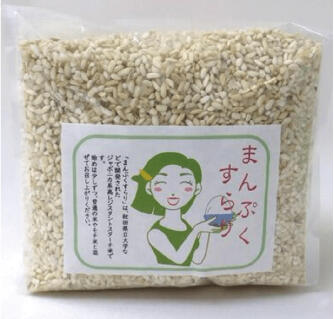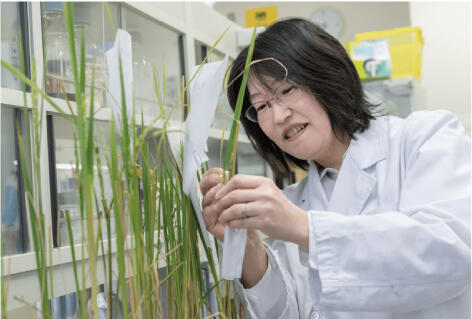(This is an English translation of the original Japanese article.
The publication date refers to that of the Japanese version,
which differs from the upload date of the English version.)
Due to the spread of Western-style diet and other factors, one in five adults over 20 years old is said to have diabetes or its precursor. In response, a research group led by Akita Prefectural University have developed a new variety of rice that may help lower blood sugar levels. They have also created unique new products using this rice. These rice and products can have a triple benefit of preventing lifestyle-related diseases, increasing rice consumption, and revitalizing rice-producing areas.
Birth of Special Rice
Starch Technologies Co., Ltd. is a venture company originating from Akita Prefectural University. It sells new varieties of rice with special features developed by the University and its partners. They are "Akita Parari*," "Akita Sarari*," and "Manpuku Surari." These rice varieties contain more resistant starch than regular rice.
"Akita Parari", a high-amylose rice, has a fluffy texture and goes well with oil. It is not powdery like Indica rice, making it suitable for dishes such as pilaf, fried rice, and curry. "Akita Sarari" is also a high-amylose rice derived from Japonica rice. When mixed with noodles, sweets, and bread as rice flour, it eliminates the stickiness that occurs when using regular rice flour. "Manpuku Surari" (photos 1 and 2) has the highest amount of resistant starch among the three varieties and gives a strong feeling of fullness after eating.
*"Parari" and "Sarari" express flaky and smooth texture respectively in Japanese.

Photo 1: "Manpuku Surari" containing a lot of resistant starch
(provided by Akita Prefectural University)

Photo 2: Paella and other dishes can be eaten deliciously even with
100% of "Manpuku Surari" (provided by Akita Prefectural University)
Inhibitory effect on blood sugar level elevation confirmed in human studies
"Manpuku Surari" is considered the most promising in terms of functionality among the three varieties because it contains nearly 10 times more resistant starch than regular rice (depending on the processing method).
Akita Prefectural University and its partners conducted tests using rice with the almost same starch structure as that of "Manpuku Surari". The subjects (20 people) were divided into two groups: one that ate rice crackers and boiled rice cooked with this variety of rice, and another that ate rice crackers and boiled rice cooked with regular rice. It was found that those who ate rice with the almost same starch structure as that of "Manpuku Surari" had significantly lower postprandial blood glucose levels and insulin secretion. These results were published in the scientific journal "Bioscience, Biotechnology, and Biochemistry" (Vol.84, pp.365-371).
Resistant starch is difficult to digest with digestive enzymes and passes through the small intestine relatively intact, reaching the large intestine where it acts similarly to dietary fiber. As a result, it is said to have functions such as improving bowel movements and serving as food for intestinal bacteria, promoting the growth of beneficial bacteria.
In addition, resistant starch is absorbed less in the small intestine than regular starch, resulting in less glucose absorption and a potential reduction in calorie intake. When calculating calories, regular starch is calculated at 4 kcal/g, while dietary fiber and resistant starch are calculated at 2 kcal/g.
Nurtured over 10 years
"Manpuku Surari" was created by a research group from Akita Prefectural University, Akita Prefectural Agricultural Experiment Station, and the Japan International Research Center for Agricultural Sciences by crossbreeding and selecting rice strains with high levels of resistant starch and high-yielding rice.
Professor Naoko Fujita (photo 3) of the Faculty of Bioresource Sciences at Akita Prefectural University, who has led the research and development, reflects on her work, saying that she has been improving the variety since around 2010 and finally succeeded in developing "Manpuku Surari".
"Manpuku Surari" applied for variety registration based on the Plant Variety Protection and Seed Act in December 2019 and is currently under review by the Ministry of Agriculture, Forestry and Fisheries. Since the cultivation method is almost the same as regular rice, producers can cultivate "Manpuku Surari" alongside regular rice cultivation.
Currently, Professor Fujita is working on developing a variety that contains more resistant starch than "Manpuku Surari" to ensure the amount of functional ingredients after processing. She is aiming for developing products that can be registered as a functional food that can claim its functionality such as helping to maintain and improve health.

Photo 3: Professor Fujita breeding new varieties
(provided by Akita Prefectural University)
Looking to export in the future, aiming for food with function claims
Cultivation of "Manpuku Surari" has already begun by producers centered in Akita Prefecture. In 2021, 12 tons of rice were harvested. In addition, Starch Technologies Co., Ltd. has developed products such as "kirintanpo (a traditional food of Akita, using gelatinized rice flour)" and miso using "Manpuku Surari" and udon using "Akita Sarari" (Photo 4). These products are sold on mail-order sites and at roadside stations in Akita Prefecture. In the future, they plan to develop and sell rice crackers and diet okowa (steamed sticky rice).
Recently, rice flour has been attracting attention in Europe and America as a "gluten-free" food that does not contain gluten, a type of protein found in wheat. In the future, there are high hopes for the export of rice flour made from "Manpuku Surari".
Professor Fujita, who has led the research, passionately shares her vision for the future: "The price of wheat flour is expected to continue to rise due to rising transportation costs and international situations. In this context, the importance of rice flour is expected to increase even further. Especially compared to regular rice flour, there is a high expectation for rice flour rich in functionality. We want to develop and release new rice that contributes to health."

Photo 4: Products using new rice, such as kiritanpo and udon noodles,
are appearing one after another (provided by Akita Prefectural University)
Project name
Research Program on Development of Innovative Technology (Development Research Stage)
Project period
FY2016 to 2018
Title
Practical application of low-calorie functional foods using mutant rice containing large amounts of resistant starch
Leading research institutes
Akita Prefectural University, Akita Prefectural Agricultural Experiment Station, Akita University, Kameda Seika Co., Ltd.
